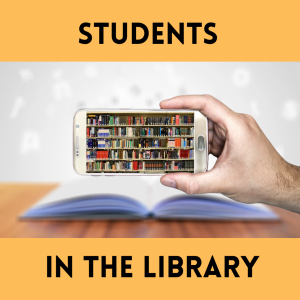What Students Say About the Library
 Following up on the Books They Read post, miniposters SEBS students created during their library session as part of their Academic Mentoring course in Fall 2022, here is recap of the humbling experience these classes pose to each librarian.
Following up on the Books They Read post, miniposters SEBS students created during their library session as part of their Academic Mentoring course in Fall 2022, here is recap of the humbling experience these classes pose to each librarian.
One can’t expect miracles from a one-shot, 80-minute session. The “less is more” principle is nowhere more important than in an environment where the unfamiliarity and novelty can give you, well, if not a full-blown anxiety attack as in a doctor’s office, but some visible discomfort. Easing into serious matters and establishing rapport with genuine interest in their struggles often helps dissipate initial resistance more than a fun Kahoot game. This is the reason for starting the session with a brief library tour on our way downstairs to the classroom. If students stop checking their phones and start asking questions after the second stop, it’s a promising sign.
There’s way too much information to process during these sessions. Each and every student arrives with their own learning styles, trying to step up to a new level by trial and error. Even a brief library instruction session designed to address the main academic stumbling blocks seems to fit perfectly into the overall mission: supporting student success at a state university.

Posters on display in Douglass Library. Click to enlarge image.
As the class progresses from a demo to hands-on searching, it’s fascinating to observe how these first-generation college students gain confidence in what they are supposed to be doing. In addition to putting into practice what they learned by actually doing it, the class activity is also designed to reinforce to them that librarians are there to help. Questions and comments during this time are equally eye-opening for the librarian, class instructor and students.
Besides the anecdotal evidence gathered during the session, the students’ brief feedback is even more valuable. Collected on decommissioned catalog cards, responses to the question, “What did you learn today?” fall into four main categories. The sample size from Fall 2022 was not very large (196 students listed 304 things that were new to them), and the methodology to process them probably wouldn’t stand up to rigorous scientific standards, but answers collected from attendees indicate a trend.
“More than books“
First-year students were pleased to discover the amount and variety of resources on site and online. They appreciated the library as a place (shown in this virtual tour) for various uses – from the calm, comfort areas to the opportunities to print, scan, and use the whiteboard. The potential of using the group study rooms for collaborative projects was the top response in this category (65 out of 128), while a few students spelled out explicitly that the library is there for their benefit. All in all, it was worth spending a few minutes at the beginning of each class and walk around the library a bit.
“Research more effectively“
The 94 responses in this more traditional theme, i.e., library research or bibliographic instruction, indicate the benefits of these resources, both immediately and in the future. QuickSearch, the library search engine, was new to almost 25 percent, according to the cards. Additionally, 14 noted the “advanced search” feature, which not demonstrated to a large extent. Students’ appreciation of the catalog function to create citations (23) and to avoid plagiarism also received a few strikes.
“Navigate the website“
A fact that surprises many of us who teach these classes is that students not only have never used the libraries’ web site, but don’t even know that it exists! Navigating the Rutgers University Libraries’ site has always been a popular answer as something new they learn in these sessions. This includes how to ask for help, such as chat reference and scheduling an appointment with a subject specialist. It sends the message to the librarian that instruction, preferably with some kind of hands-on task, should focus on the web site, and reminders that it exists should probably be posted on social media.
“Librarians and libraries are helpful“
Other than realizing that everyone has a library card, aka their student ID, 30 students expressed their overall good impressions of the library, including all the colleagues at Douglass Library who helped students before classes. Many of them said that they would definitely come back to use the library. To achieve this result, our colleagues at the Circulation desk were well informed and prepared for the influx of new students and instructors during the week in October when all sections of the SEBS Academic Mentoring course visited the library, often giving guidance and directions to latecomers.
The library sessions serve as a great example of collaboration within the library and with large, campus-wide programs and initiatives such as the Academic Mentoring course offered to first-year first-generation college students by the SEBS Office of Academic Programs.
The informal feedback received from nearly 200 students has definitely confirmed the need for this course. The library has something to offer to everyone, whether it’s for schoolwork or fun.

Stessbusters in Chang Library from past years